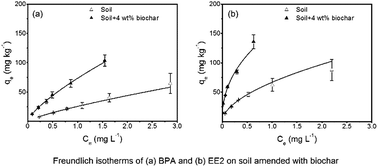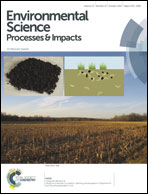Influence of biochar on sorption, leaching and dissipation of bisphenol A and 17α-ethynylestradiol in soil
Abstract
Biochar, as a soil amendment, provided a very cost-effective, convenient route to dispose organic residues. In the present study, the impact of adding biochar on the sorption, leaching and dissipation processes of bisphenol A (BPA) and 17α-ethynylestradiol (EE2) in soil was investigated. The biochar derived from corn stalks at 500 °C for 1.5 h was characterized by a highly aromatic and microporous structure with various functional groups on the surface. In the batch sorption studies, the application of 4 wt% biochar to soil significantly increased the solid–water distribution coefficients by 263% for BPA and by 298% for EE2 at the pollutant equilibrium concentration of 0.01 mg L−1. In the leaching experiment, after five leaching periods, soil amended with 1 wt%, 2 wt% and 4 wt% biochar reduced the cumulative amount by 19%, 28% and 53% for BPA, 42%, 58% and 77% for EE2 compared to the biochar-free soil. Interestingly, during the 90 d incubation experiment, BPA and EE2 dissipations were not significantly affected by the added biochar, while remarkable decreases of CaCl2 extractable BPA and EE2 were observed. The overall results highlighted the distinctive potential of this biochar in reducing the mobility of BPA and EE2 in soil, meanwhile without attenuating the degradation of the two pollutants.


 Please wait while we load your content...
Please wait while we load your content...